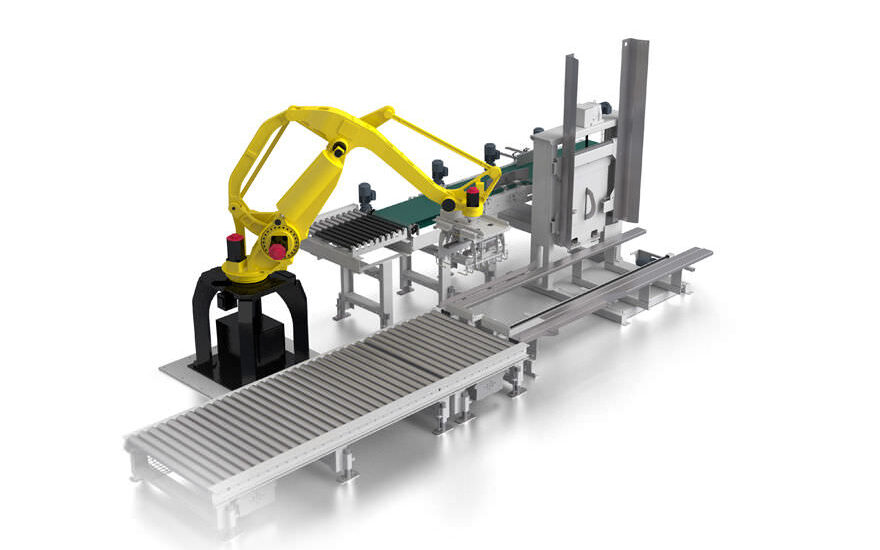The global robotic palletizers & de-palletizers market is poised for robust growth, with projections indicating a steady Compound Annual Growth Rate (CAGR) of 4.7% during the forecast period. Forecasts suggest that the market will achieve a valuation of US$ 2.53 billion in 2023, surging to exceed US$ 4.0 billion by 2033.
Driving Forces of the Robotic Palletizers & De-palletizers Market:
- Enhanced Handling and Multi-line Operations: Robotic palletizers & de-palletizers offer superior handling capabilities for high-SKU counts and enable efficient alignment of multi-line operations, making them increasingly preferred over conventional counterparts.
- Operational Efficiency: Manual palletizing is often impractical for large or heavy pallet loads and can result in product damage due to mishandling. Robotic systems overcome these limitations, offering high operational efficiency, speed, and accuracy, especially in extreme climatic conditions.
- Productivity and Economic Viability: Despite higher initial investment costs compared to manual labor, robotic palletizers & de-palletizers deliver long-term economic benefits through increased productivity, reduced labor costs, and enhanced operational efficiency.
Get a Sample PDF of the Report: https://www.futuremarketinsights.com/reports/sample/rep-gb-12681
Growth Factors and Opportunities:
- High Productivity and Automation: Increasing automation in urban environments, coupled with rising labor costs, fosters market growth by emphasizing productivity and operational efficiency.
- Government Norms for Worker Safety: The enforcement of safety regulations by governments drives the adoption of robotic palletizers & de-palletizers, offering enhanced safety for workers operating in packaging lines.gMarket Innovation:
- Vision Systems Integration: Innovations in robotic palletizers and de-palletizers include the integration of advanced vision systems, allowing robots to precisely identify, locate, and handle items on pallets, enhancing efficiency and reducing errors.
- Collaborative Robotics: The introduction of collaborative robots, or cobots, in palletizing and de-palletizing processes allows for safer interaction between robots and human workers, promoting flexibility and ease of deployment.
- AI-Based Programming: Robotic systems equipped with artificial intelligence (AI) enable more intuitive and adaptive programming, allowing robots to learn and optimize their performance over time, leading to increased operational efficiency.
- End-of-Arm Tooling Advancements: Continuous innovations in end-of-arm tooling, such as grippers and suction cups, enhance the versatility of robotic palletizers, enabling them to handle a wide range of products with varying shapes, sizes, and weights.
- Cloud Connectivity and Remote Monitoring: Integration of cloud connectivity and remote monitoring features in robotic palletizing systems allows for real-time data analysis, predictive maintenance, and seamless control over robotic operations from remote locations.
Growth Opportunities in Robotic Palletizers & De-Palletizers Industry:
- Automation Integration: Increasing demand for seamless integration of robotic palletizing and de-palletizing systems with other warehouse automation technologies, such as conveyor systems and robotic arms, presents a significant growth opportunity.
- E-commerce Expansion: With the continuous growth of e-commerce, there is a rising need for efficient and high-speed palletizing solutions to handle the increased volume of goods in distribution centers.
- Customization and Flexibility: Companies providing robotic solutions that offer flexibility and customization to adapt to diverse product types and packaging configurations will have a competitive edge as industries demand more versatile solutions.
- International Market Penetration: Expansion into emerging markets and the globalization of supply chains create opportunities for robotic palletizer manufacturers to meet the growing demand for automated material handling solutions worldwide.
- Enhanced Software Solutions: Growth opportunities lie in the development of advanced software solutions that improve the overall efficiency, adaptability, and predictive maintenance capabilities of robotic palletizing and de-palletizing systems.
- Layer Depalletizing & Palletizing Solutions: The emergence of innovative layer depalletizing & palletizing solutions heralds new trends in the market, catering to evolving industry needs and demands.
Request Report Methodology: https://www.futuremarketinsights.com/request-report-methodology/rep-gb-12681
Industry Trends:
- Collaborative Robotics: The industry is witnessing a trend towards the integration of collaborative robots (cobots) in palletizing and de-palletizing applications, ensuring safer human-robot collaboration in warehouse environments.
- Artificial Intelligence (AI) and Machine Learning (ML): The incorporation of AI and ML algorithms in robotic systems is becoming a trend, enabling these machines to optimize palletizing processes, learn from data, and adapt to changing conditions in real-time.
- Sustainability Focus: There is a growing emphasis on sustainability in the design and operation of robotic palletizers, with trends towards energy-efficient solutions, recyclable materials, and reduced environmental impact.
- Integration of Vision Systems: The integration of advanced vision systems, including 3D cameras and sensors, is a prevailing trend. This enhances the accuracy and speed of palletizing and de-palletizing operations, especially in handling irregularly shaped or fragile items.
- Remote Monitoring and Maintenance: The adoption of remote monitoring and predictive maintenance capabilities is on the rise, allowing companies to proactively address potential issues, minimize downtime, and optimize the performance of robotic palletizing systems.
Recent Market Developments:
- Kawasaki Heavy Industries has extended its CP series with CP180L and CP300L with floor mounting, and easy-to-use palletizing software. This comes with the flexible automation of end-of-line and distribution processes.
- Yaskawa Electric Corporation has revisited its robotic palletizers. The robots are expected to offer speed and safety along with more space. The robots are flexible with easy-to-integrate 2D and 3D vision systems.
Purchase Now to Access Segment-specific Information and uncover Key Trends, Drivers, and Challenges: https://www.futuremarketinsights.com/checkout/12681
Key Segments
By Product Type:
Palletizers:
- Boxes/Cases
- Bags/Sacks
- Bundles
- Others (Pails, Drums, Trays etc.)
De-Palletizers:
- Boxes/Cases
- Bags/Sacks
- Bundles
- Others (Pails, Drums, Trays etc.)
By Place:
- Factories
- Distribution Centers (DCs)
- Fulfilment Centers (FCs)
- Others
By Machine Type:
- Articulated Robots
- Collaborative Robots
By Application:
- Food and Beverages
- Pharmaceutical
- Consumer Products
- Tracking and Logistics
- Industrial Packaging
Author
Ismail Sutaria (Lead Consultant, Packaging and Materials) has over 8 years of experience in market research and consulting in the packaging & materials industry. Ismail’s strength lies in identifying key challenges faced by the client and offering logical and actionable insights to equip the clients with strategic decision-making power.
Ismail has been an instrumental part of several transformational consulting assignments. His key skills include competitive benchmarking, opportunity assessment, macroeconomic analysis, and business transformation advisory. Ismail is an MBA holder in Marketing and has a Bachelor’s Degree in Mathematics.
About Future Market Insights (FMI)
Future Market Insights, Inc. (ESOMAR certified, recipient of the Stevie Award, and a member of the Greater New York Chamber of Commerce) offers profound insights into the driving factors that are boosting demand in the market. FMI stands as the leading global provider of market intelligence, advisory services, consulting, and events for the Packaging, Food and Beverage, Consumer, Technology, Healthcare, Industrial, and Chemicals markets. With a vast team of over 400 analysts worldwide, FMI provides global, regional, and local expertise on diverse domains and industry trends across more than 110 countries.
Contact Us:
Future Market Insights Inc.
Christiana Corporate, 200 Continental Drive,
Suite 401, Newark, Delaware – 19713, USA
T: +1-845-579-5705
For Sales Enquiries: sales@futuremarketinsights.com
Website: https://www.futuremarketinsights.com
LinkedIn| Twitter| Blogs | YouTube



